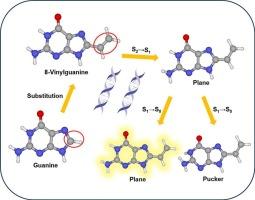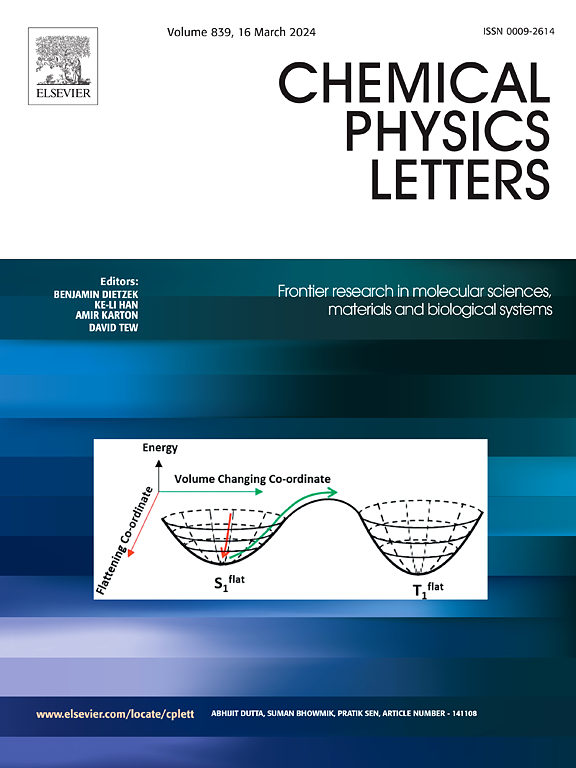The excited state deactivation mechanism of 8-Vinylguanine: Competition between fluorescence and nonadiabatic process
IF 3.1
3区 化学
Q3 CHEMISTRY, PHYSICAL
引用次数: 0
Abstract
The stable inheritance of genetic information in DNA and RNA relies critically on the exceptional photostability of nucleobases, which rapidly dissipate absorbed UV energy through ultrafast nonradiative pathways. Modifying nucleobases offers a powerful strategy for tuning their photophysical and photochemical properties. 8-Vinylguanine (8vG), a guanine analogue featuring a vinyl substitution at the C8 position, exhibits intense fluorescence upon photoexcitation, distinguishing it from the natural guanine. In this work, we investigate the complex deactivation mechanism of 8vG in its excited state by combining high-level electronic structure calculations with excited-state on-the-fly surface hopping nonadiabatic dynamics simulations. Our results show that nonradiative decay primarily occurs through a ring puckering motion within the guanine moiety, directly competing with fluorescence emission. Consequently, 8vG exhibits a significantly prolonged excited-state lifetime compared to unmodified guanine. This study provides a detailed mechanistic understanding of the competition between fluorescence and nonradiative decay in 8vG, offering fundamental insights for the rational design of bio-inspired photostable systems or fluorescent probes with tunable properties.

8-乙烯基鸟嘌呤激发态失活机制:荧光与非绝热过程的竞争
DNA和RNA遗传信息的稳定遗传主要依赖于核碱基的特殊光稳定性,核碱基通过超快的非辐射途径迅速耗散吸收的紫外线能量。修饰核碱基为调整其光物理和光化学性质提供了一种强有力的策略。8-乙烯基鸟嘌呤(8vG)是一种鸟嘌呤类似物,在C8位置上具有乙烯基取代,在光激发下表现出强烈的荧光,与天然鸟嘌呤不同。在这项工作中,我们通过结合高层次的电子结构计算和激发态上的表面跳跃非绝热动力学模拟来研究8vG在激发态下的复杂失活机制。我们的研究结果表明,非辐射衰变主要通过鸟嘌呤部分内的环皱缩运动发生,直接与荧光发射竞争。因此,与未修饰的鸟嘌呤相比,8vG表现出明显延长的激发态寿命。该研究为8vG中荧光和非辐射衰变之间的竞争提供了详细的机制理解,为合理设计具有可调特性的生物启发光稳定系统或荧光探针提供了基本见解。
本文章由计算机程序翻译,如有差异,请以英文原文为准。
求助全文
约1分钟内获得全文
求助全文
来源期刊

Chemical Physics Letters
化学-物理:原子、分子和化学物理
CiteScore
5.70
自引率
3.60%
发文量
798
审稿时长
33 days
期刊介绍:
Chemical Physics Letters has an open access mirror journal, Chemical Physics Letters: X, sharing the same aims and scope, editorial team, submission system and rigorous peer review.
Chemical Physics Letters publishes brief reports on molecules, interfaces, condensed phases, nanomaterials and nanostructures, polymers, biomolecular systems, and energy conversion and storage.
Criteria for publication are quality, urgency and impact. Further, experimental results reported in the journal have direct relevance for theory, and theoretical developments or non-routine computations relate directly to experiment. Manuscripts must satisfy these criteria and should not be minor extensions of previous work.
 求助内容:
求助内容: 应助结果提醒方式:
应助结果提醒方式:


